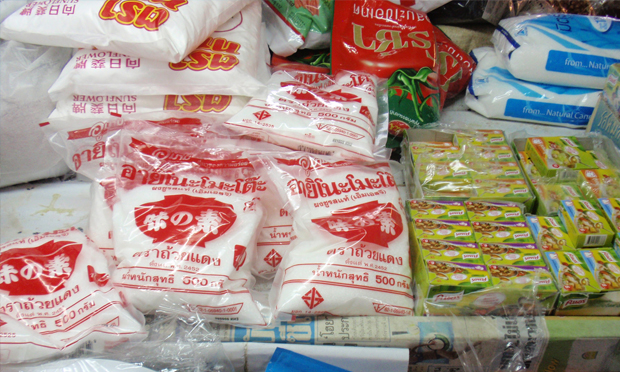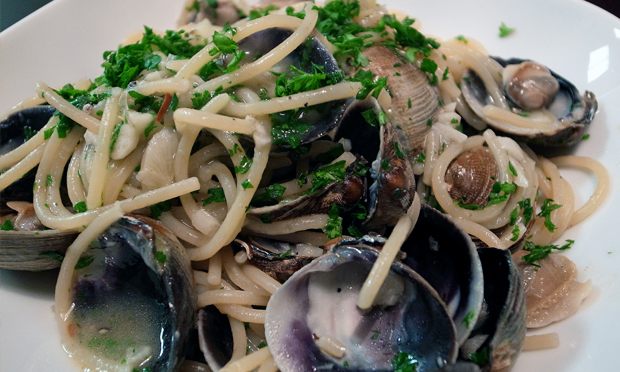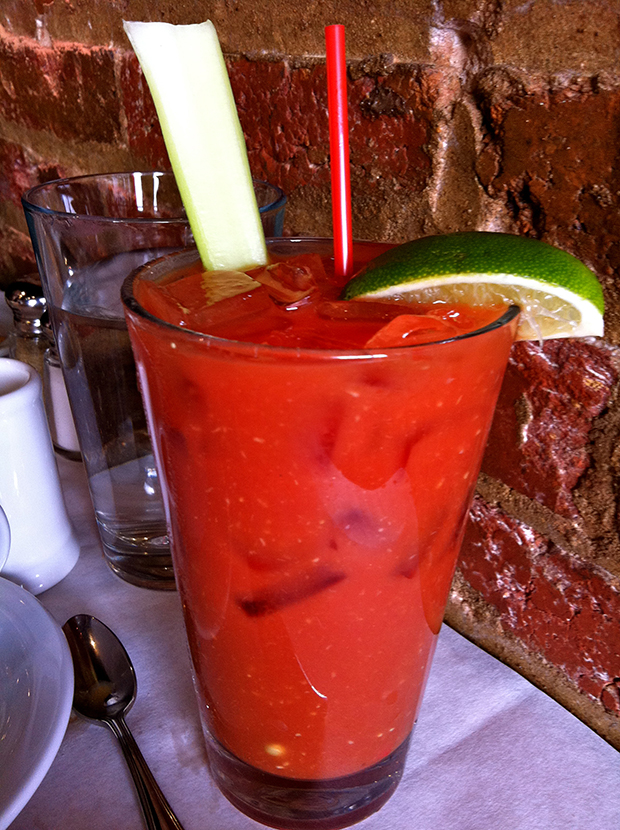Do me a flavour – Gillian Riley on umami

Monosodium glutamate (MSG): umami in its controversial chemical form. Photograph: J.M. Lawton
Umami is known as the fifth taste, the others being sweet, salty, bitter and sour, and is best described as ‘deliciousness’.
There’s a lot of it about in Hackney: you can slosh tomato ketchup on a burger, or breathe in the delicate aroma of a bowl of miso soup, or sprinkle freshly grated Parmesan cheese on your pasta, or savour the anchovy and tomato on a pizza, or add soy sauce to a stir fry, or plunge your head into a pungent vat of pho, or eat a marmite sandwich.
Or you can go to one of Hackney’s many oriental food stores and buy yourself a little jar of MSG, monosodium glutamate, the chemical version of umami, and just add a bit to whatever you are cooking. But better still go and get the tasty ingredients that used together will give you that deliciousness and so much more.
Back in the day the Health Police and many earnest foodies were consumed with righteous indignation at the thought of putting some kind of chemical additive into boring food to make it taste better. Stuff of poor nutritional quality was being given a dishonest boost by the food industry – they profited, and we got poorly.
Then there was the shameful notion of ‘Chinese Restaurant Syndrome’ which was supposed to make you feel weak, giddy and unwell after eating food laced with MSG. Although it could have been the copious amounts of lager you took on board with your chop suey (not a genuine Chinese dish anyway) that produced the symptoms. The stigma of MSG remained. Until we rediscovered it as umami, and got to know and love it. Today umami is both a trendy concept and chemical substance, but above all a way of getting deliciousness into our food, and we can all get a lot of fun out of using ingredients that do this.
A new generation of intelligent and inventive young chefs are working with naturally occurring umami in a whole range of ingredients, to make their creations more delicious, and more notorious, than ever before, with foams, sprays, splurges, dribbles and blobs of flavour.
Laura Santtini uses a restrained range of pastes, rubs and dusts to reinforce her professional repertoire. Her books have easy to follow imaginative versions of new and traditional recipes, and it is not too far as the crow flies from Hackney to the suave purlieus of Belgravia, where you can taste them in the Santtini restaurant. But pity the poor crow and wander instead round my comfort zones of Mare Street and Kingsland Road, Shoreditch and Hoxton.
Last month’s East End Review was oozing umami in all its restaurant reviews, from champagne-poached oyster, truffle oil, caviar and scrambled eggs at Chriskitch in Hoxton, to Korean style chicken wings at Andy’s Swing Bar, or a tasty vegan burger in Clapton. The rice bowl offered at lunch at Jidori is pepped up with seaweed, fresh spinach, pickled cabbage, as well as the yakitori chicken in its crisp umami glaze.
Just a little bit of tomato and cheese on a pizza, a sliver of anchovy, a few leaves of oregano, welded together with heat and oil, the aroma and crunch of almost singed bread dough says it all! But Italian food was rich in umami long before the tomato arrived. A simple dish like Spaghetti alle Vongole shows how the combination of olive oil and clam juices with garlic, chilli and parsley (no tomatoes, no cheese) gives a great whoosh of flavour. Umami is both a trendy concept and a chemical substance, but above all a way of getting deliciousness.

Rich in umami: Spaghetti alle Vongole. Photograph: Naotake Murayama
Umami was first isolated and described by the Japanese scientist Kikunae Ikeda in 1908. He not only identified it as the fifth taste, but devised a way of producing it commercially, known as MSG. But the combination of glutamates and nucleotides, inosinates and guanylate is not rocket science, so all we need to know in the kitchen and when shopping is what ingredients have it, and how to put them together. We don’t need that little jar of MSG. Instead we can find out online or in books which foodstuffs or seasonings to go for. The magical ones are seaweed, dried bonito flakes, anchovies, oriental fish sauce (Thai nam pla, or Vietnamese nuoc mam), soy sauce, oyster sauce, mushrooms (especially dried shiitake), tomatoes (fresh, dried, as concentrate in tins or tubes), Parmesan cheese, cured bacon and ham (especially Parma or San Daniele) and the various chilli/bean pastes from China, Korea and the Far East, as well as miso from Japan.
These pastes are used to brighten up soups and stews, or diluted to make dipping sauces. Sichuan chilli broad bean paste is made from chillies, broad beans, salt and wheat flour only, put to ferment and mature in outdoor jars or vats for as long as eight years. Pixian, near the Chinese city of Chengdu, is where the best is made.

The tomato juice in a Bloody Mary gives it its umami taste: Photograph: Tammy Gordon
Umami stars in an investigation of the awfulness of airline food by Charles Spence, Professor of Experimental Psychology at the Crossmodal Research Laboratory in Oxford, who has shown in various experiments how the atmosphere during long-haul flights makes even delicious food seem tasteless and dreary. Apart from the usual travel anxieties such as fear of flying, worries over passports, tickets and incontinence, the dryness of the atmosphere combines with the considerable cabin noise in the background to wreck our perceptions of the sweet, salty, sour and bitter taste of the food and drink on offer. The considerable background noise is indeed the biggest factor, for it impedes our perception of all the tastes – except umami. Pity those in business class with their joyless champagne and Bordeaux, whilst the hoi polloi sip with pleasure banal Bloody Marys, where the umami in the tomato juice is a winner.
My delight in the innovative uses of umami by bright young chefs today is exceeded by astonishment at the way it was used in the past when not a living soul had ever heard of it. For centuries cooks all over the world instinctively put things together that produced the ‘deliciousness’ analysed by Kikunae Ikeda. A poem by Virgil describes a peasant, Simulus, pounding garlic with wild herbs and cheese to make a paste to brighten up a batch of flatbread, an early sighting of umami. Remind you of something? Pesto Genovese, made with basil, garlic, olive oil, salt and pecorino or Parmesan, to add zest to a dish of local pasta. This use of cheese to enhance flavours rather than give ‘cheesiness’ to food is at its most extreme in Parmesan ice cream, which tastes of especially rich sweet cream, if you use a flavourful sugar. If you bite into a lump of good quality Parmesan cheese the burst of flavour comes with the crunch of a crystalline substance that is not salt, but pure umami. In Emilia, where Parmesan is made, they often serve lumps of Parmesan at the end of a meal with a swirl of the genuine aceto balsamico tradizionale di Modena, a double dose of umami. Our footsore legionary plodding up Stamford Hill to Hadrian’s Wall, would find when he got there that the garrison was provisioned with imported fish sauce and olives, to give a boost to the home-made bread along with hard cheese and local herbs such as thyme, parsley and fennel.
Simulus the peasant was doing what more sophisticated Roman cooks got up to in their kitchens, using herbs and cheese along with garum or liquamen (similar to today’s Thai or Vietnamese fish sauce), sweet wine or honey, and spices and herbs, to give bursts of flavour to ordinary ingredients. Apicius, the 1st century gourmet and glutton, is the name tagged on to a much later collection of recipes from blue-collar cooks in Ancient Rome, and we are fortunate to have versions of these tested by Sally Grainger, who is both a professional cook and a classicist.
Here is my recipe for Apician Spiced Pork Belly, based on her version of a pork dish from the 1st century called Ofellae:
750 g pork belly, boned
A rub of two teaspoons each of dill seeds, cumin seeds, lovage seeds, black peppercorns, a pinch of asafoetida
one or two bay leaves
Fish sauce
Garlic
Honey or Pekmes (Turkish reduced grape must)
Dry roast the herbs and spices in a heavy frying pan, and grind them with a pestle and mortar (the best and quickest way), before adding 1tsp of fish sauce. Lay the pork skin side down and score it with a sharp knife to make three centimetre squares, but without cutting through the skin. Anoint with the mixture, rubbing it in well (at this stage I add chopped garlic to taste, which is not in the original recipe). Leave it to marinate for a day or so. Then slow roast in the oven for several hours, when the cubes of meat and fat, now so tasty, will fall off the skin. Serve with a sauce comprising 2tsp fish sauce, freshly ground black peppercorns, lovage seeds, and honey or pekmes.
Serve this with Apicius’s simple melon salad:
Melon Salad
One really ripe and fragrant melon, cut into 15mm cubes
A dressing of fish sauce, runny honey or palm sugar, freshly ground black pepper, mixed until the sugar or honey dissolves.
Pour the dressing over the melon and stir well, and add some finely chopped fresh mint or pennyroyal. The different umami ingredients in these two recipes bring out the aroma of the melon and the meatiness of the pork.
